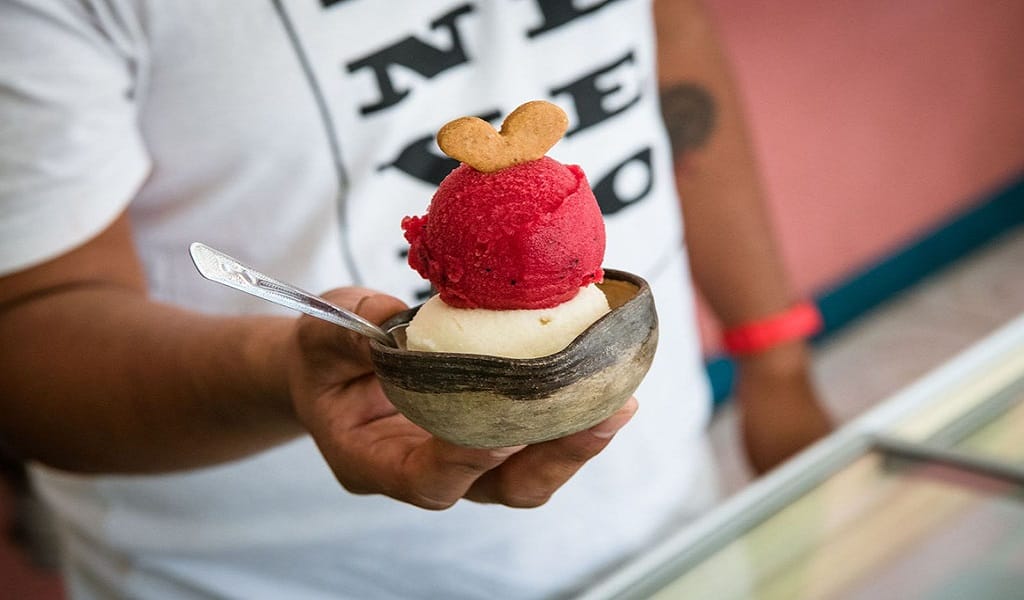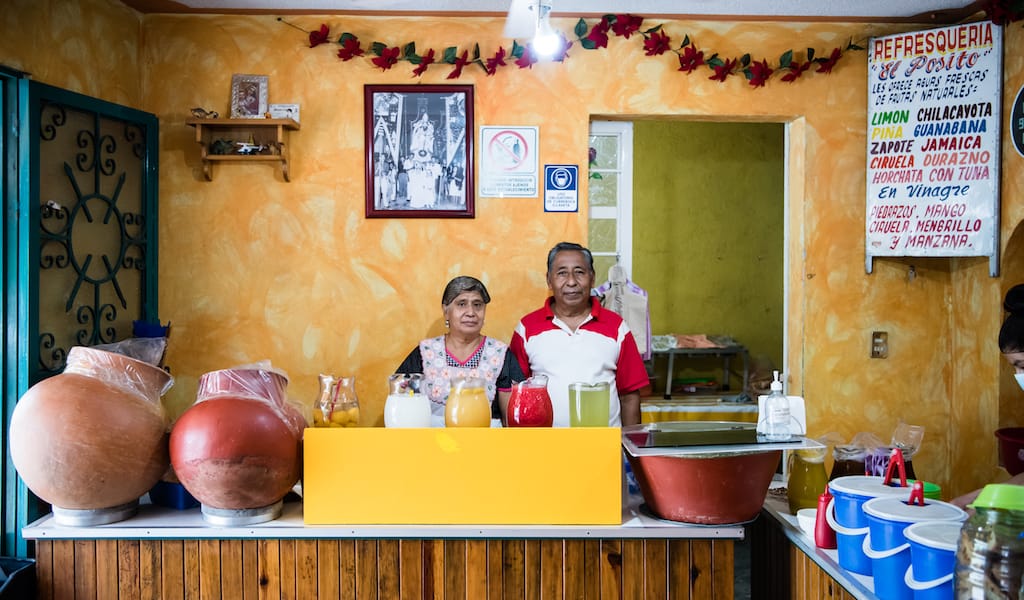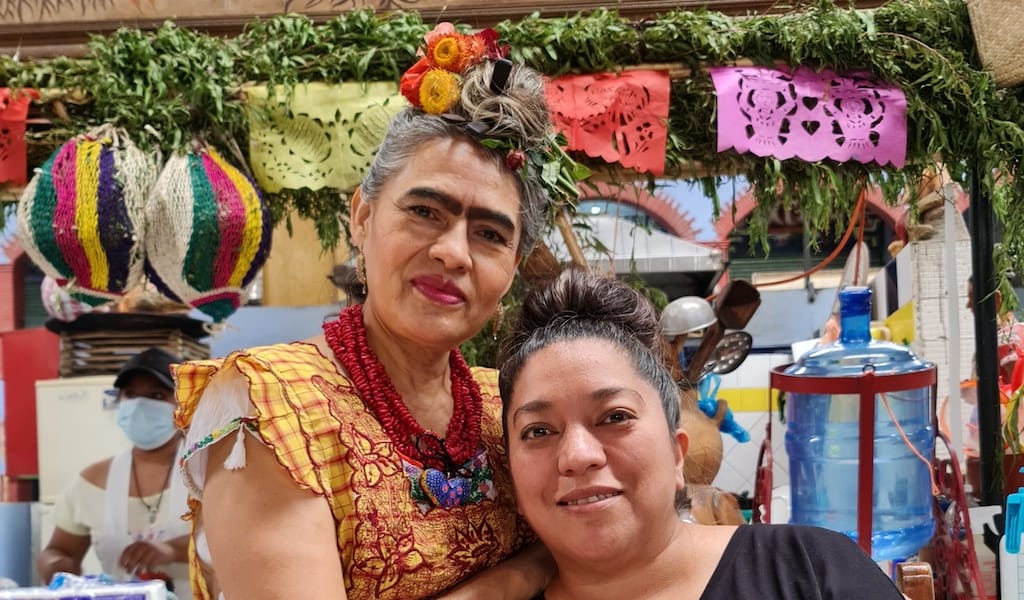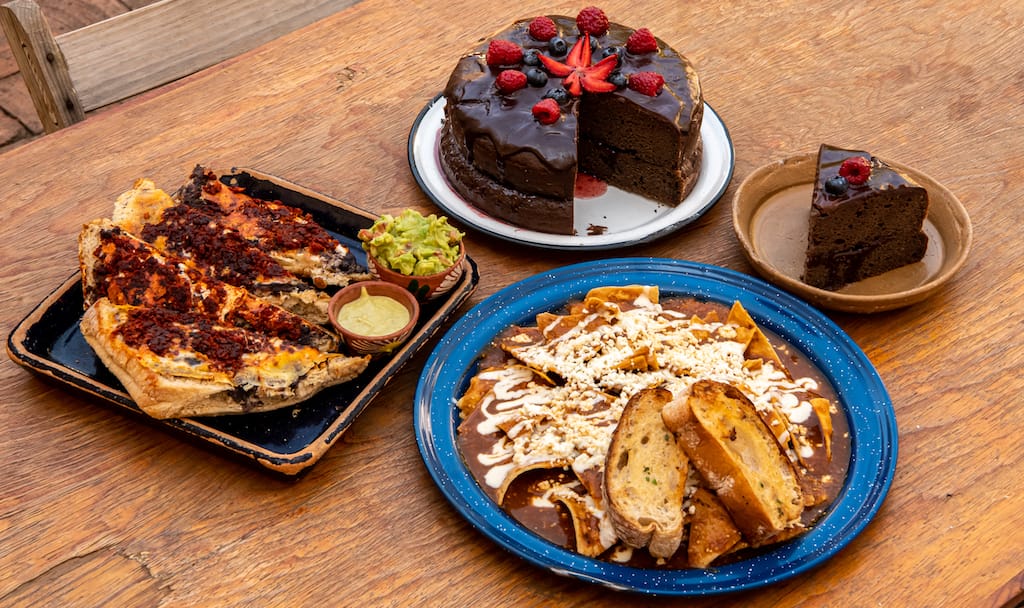Gathered in the parks of Oaxaca during the early 2000s, groups of high school friends, including our dear Roberto, would herald in the end of another school year and the start of a summer of easy living with refreshing nieves in hand. A cup of icy, colorful nieve marked the beginning of carefree afternoons and liberation from homework. Lined up in their wooden containers, the diverse and bright array of fruit nieves resembled the exuberance of the summer unfolding around us: the rich green of the trees, the gentle yellow of the afternoon sun and petricor – a beautiful Spanish word describing the subtle and comforting smell of moist earth after rain.
For new tasters, the idea of nieves could be easily mistaken for ice cream, though they are actually closer to sherbet because of their ingredients and texture. While ice cream has milk or cream as the main ingredient, nieves, in broad terms, are a mix of fruit extract (or another main ingredient) and sugar – sometimes with a dash of milk. Nieves are produced in garrafas, a set of two nested tubs; a smaller tub of stainless steel is where the ingredients go, surrounded by a bigger tub made of wood. Between these two containers, the neveros add chunks of ice covered with sea salt, which are the “fuel” that help freeze the ingredients, while the inner tub is spun until everything inside has integrated and smoothened out. Though technically this technique was brought by the Spanish (who learned it from the Italians), a simpler version of nieves was already being consumed by Mesoamericans, who mixed ice collected from the cold mountains with honey and a variety of juices made from local fruits. These included flavors like mamey, tuna (prickly pear) and capulin cherries.
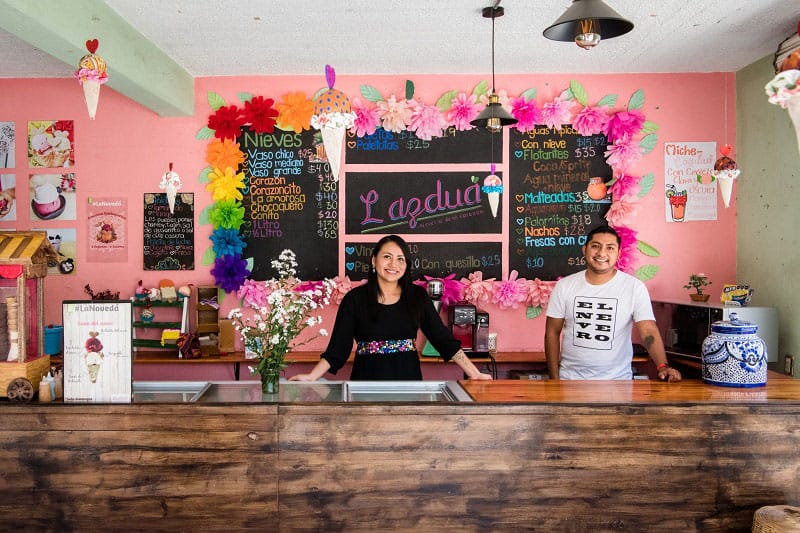
“The nieve-making process is all about balance and flavoring. The point is producing a nieve where the flavor of fruit itself is quite intense and never overshadowed by sugar, while the texture is somewhat silky and never watery,” says Erick Ramírez Flores, the 33-year-old co-owner of Lazduá, a nevería located in the Zapotec village of Tlacolula. The village is a 35-minute drive from Oaxaca City, and happens to be the birthplace of Roberto, who took us to Lazduá – perhaps in an unconscious attempt to revisit that teenage excitement felt at the beginning of summer. It was an attempt that was 100% successful, we might add.
Famous for being a place of traders and craftspeople, Tlacoula undoubtedly holds the title for best nieves across the Oaxaca Valley. “The most representative nieve in Oaxaca is leche quemada with prickly pear.” This roughly translates to burnt or smoked milk, and is made with milk that has been slightly burned in a clay pot, then steeped in smoke for hours. “According to the elders, this nieve symbolizes the traditional attire of Tlacolulan women. We could say the nieves are deeply rooted in Tlacolula’s culture. All sorts of celebrations, particularly weddings and christenings, need to have nieve at the table. I’ve always thought it is a sort of good omen that promises a path full of sweetness and joy,” says 31-year-old Sinaí Mendez Altamirano, Erick’s wife and partner at Lazduá.
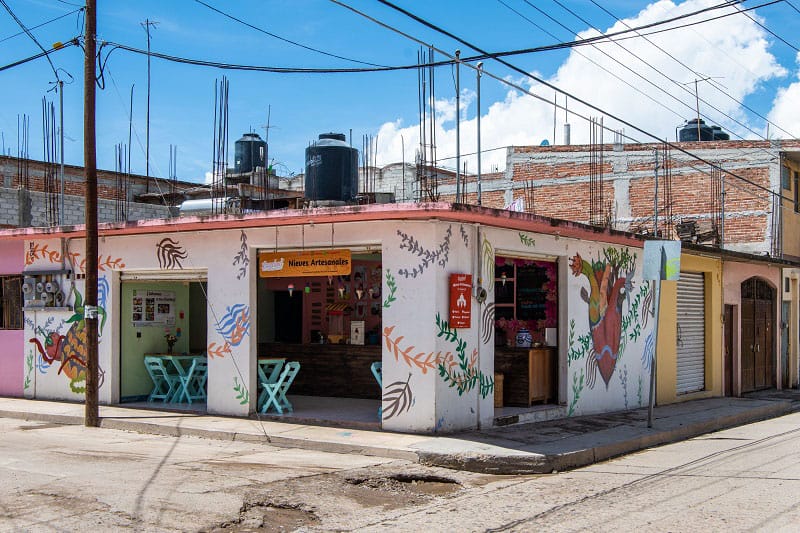
In Oaxaca, as well as other states of Mexico, nieves are not only the ideal summer dessert, but they also encompass hundreds of years of experience from their churners, the neveros. Erick and Sinaí’s nevería has been up and running for five years, but the recipes and techniques they use come for Erick’s family, whose art for nieve-making goes back 50 years, when the late Don Vicente Ramírez started making and selling the frozen treat on a bicycle he baptized La Sorpresa (the surprise). A few years later, Don Vicente and his wife, Doña Mercedes Flores (now 72), established the little stall Aracely, which is still headed by the doña. Vicente and Mercedes’s well-respected nevería has since given birth to three new operations, each run by their sons. All have maintained the high-quality standards set by their parents, and Lazduá is no exception. And while nieves are an undeniable part of Tlacolula’s foodscape, Don Vicente’s legacy was cemented in the 60s, when he managed to achieve the perfect balance between fruit and sugar, creating new flavors and adding his own touch to old recipes. One favorite is the nieve de mezcal. “He had the soul of an alchemist, and I think we all inherited it. I cannot point to a moment when somebody started teaching me – I just learned,” says Erick, smiling as he remembers his father’s hardworking spirit.
A cup of icy, colorful nieve marked the beginning of carefree afternoons and liberation from homework.
In the indigenous Zapotec language, spoken in the Valley of Tlacolula, lazduá is an offering that comes from the soul or heart. In other words, anything that has lazduá has a great deal of genuine feeling. “Six years ago, we realized how hard it was for us to find a job related to our career,” says Erick, who studied communications. Meanwhile, his family’s nevería hadn’t seen the touch of Erick’s father since he had passed away almost 20 years ago. “I had the opportunity to join the family business, and we decided to give it a try. We made a batch of different nieves and sold them at a bazar for local designers and sustainable products. That day, a man kept coming back to our stall. He told me our nieves reminded him of ones he tried in Tlacolula many years before. ‘The nieves of Don Vicente,’ he said. My soul was shaken, and Lazduá was born,” recalls Erick.
While Erick is the root of a powerful legacy, Sinaí represents the pulse of innovation. Her visionary mind helped push the nevería to an entirely new level. She started their delivery service to Oaxaca City and added other nieve-based products to the menu, such as the nieve-float, inspired by the ice cream float served at soda fountains in the 50s. Sinaí also made direct contact with local fruit producers, and created a line of nieves sweetened with agave honey, for those with diabetes or special nutritional needs. “We use the concept of lazduá in everything we do, from the décor down to the cups, the toppings and our attitude when creating new recipes. We want to make our customers happy with all our heart,” explains Sinaí.
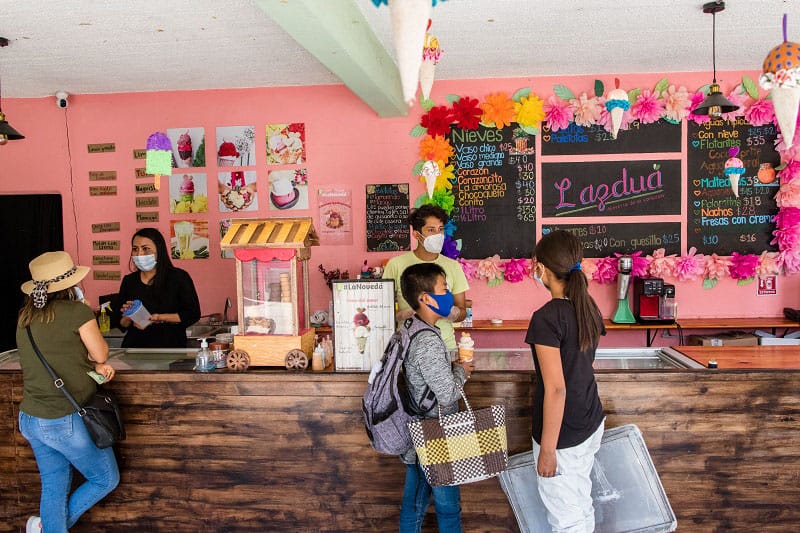
From the lush espadín tropicoso (pineapple, worm salt and mezcal) to lime with spearmint, and from almond cappuccino to the silky classics of mamey or leche quemada (smoked milk), the duo have created an ever-increasing list of exciting new flavors, without leaving the traditional ones behind. “We have clients of all ages: old clients from my parents’ nevería and younger generations. Then we have clients like restaurants in Oaxaca City, or event planners outside Oaxaca. This is also the reason why we wanted to use a Zapotec word as our banner and name. We want people to turn their eyes on Tlacolula and see nothing is impossible if you have a meaningful project,” says Sinaí.
As we enjoyed a selection of classic and new nieve flavors on a typical Oaxacan summer Sunday, we realized that, although we were no longer teenagers, we felt just as we did in those days. “There was something about nieves in the park that made me feel the world belonged to me and blooming summer days were bells announcing an exciting future. I am starting to feel the same way today,” says Roberto, in a dreamy tone. The pandemic suddenly feels years away, and we are healthy and ready to embrace the heat – only this time, we could do it with a cranberry red wine nieve in hand.
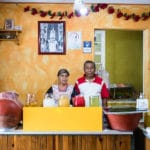 August 20, 2021 El Posito
August 20, 2021 El Posito
Back in our college days, in the mid 2000s in Mexico City, we spent hours talking with […] Posted in Oaxaca September 8, 2021 La Cocina de Frida
September 8, 2021 La Cocina de Frida
On my way out of Oaxaca center and on to the city of Santa Catarina Minas, a good friend […] Posted in Oaxaca April 11, 2024 Oscuro Brebaje
April 11, 2024 Oscuro Brebaje
As difficult as the last two years have been for food businesses, it has offered many […] Posted in Oaxaca
María ÍtakaJalil Olmedo
Published on July 09, 2021
Related stories
August 20, 2021
OaxacaBack in our college days, in the mid 2000s in Mexico City, we spent hours talking with our fellow students about the foods we missed the most from home. When we, the “Oaxacan delegation,” brought up piedrazos, everyone in the room laughed. They could not fathom something with such a name – piedrazo literally means…
September 8, 2021
OaxacaOn my way out of Oaxaca center and on to the city of Santa Catarina Minas, a good friend suggested I make a pit stop to visit “Frida.” Me: “Wait! Frida? Frida Kahlo the Mexican art icon? But she died in 1954!” Him: “You'd better go and try her chile encuerado.” So here I am,…
April 11, 2024
OaxacaAs difficult as the last two years have been for food businesses, it has offered many establishments an opportunity to rethink how they do things and come back with a greater sense of purpose. Take the example of Oaxaca’s Oscuro Brebaje, a café that took a pause, only to emerge stronger and more inviting. Founded…







































